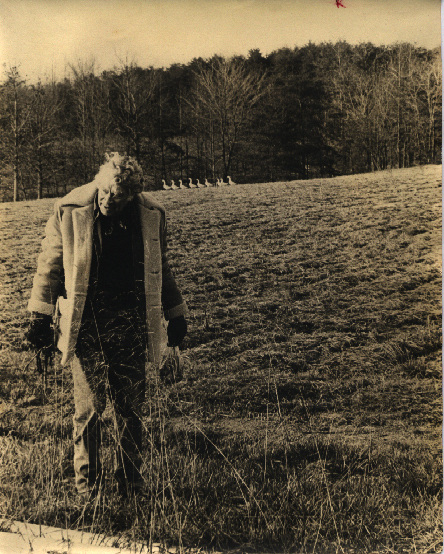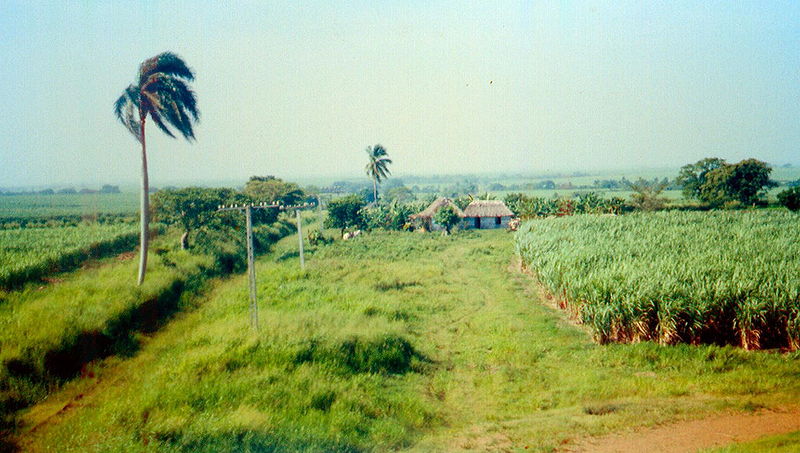Front to back: Ruth, Chastity, and Ken. Ken is watering a young blueberry bush.
Category: Sustainable living
Bat houses
I finally got my bat houses put up yesterday. There were carpenters here to work on making Acorn Abbey more waterproof, and while they were here I asked them to use their ladder to put up the bat houses. I bought the bat houses from the Organization for Bat Conservation. The bat houses are at the edge of the woods behind the house, above the new fire pit.
I do have bats here. They can be seen any evening at dusk, dive-bombing for insects. I’ve learned that I don’t even have to go outdoors to watch them. If at dusk I stand upstairs in front of the gothic windows and turn on the outdoor floodlights, soon the bats will come, chasing the bugs drawn by the lights (there are two big floodlights mounted under the eaves on each corner of the house). Sometimes the bats will dive-bomb straight for the windows. This gives an effect that is both gothic and a bit techie. It reminds me of the scenes in Star Wars in which the evil emperor sits in his big chair facing a big window looking out on a space battle, with the fighter craft swarming. The bats’ dives sometimes come quite close to the gothic windows, then they make steep turns to avoid the windows. You can see the underbellies of the bats.
The carpenters, actually, were my nephew, Russ, and his helper. They caulked around all the windows, installed metal flashing at the bottom of each window to deflect the water that runs down to the window sill, installed metal flashing around all the eaves to keep runoff from the roof from hitting the wood facia, and installed a large attic vent so that when I turn on my attic fan there’s enough vent space for the exhaust to escape. Though I do use air conditioning at Acorn Abbey, I also tried to build the house so that it’s livable without air conditioning. If I open north-facing downstairs windows and turn on the attic fan, strong breezes from the cool side of the house pour in. The fan is huge and has the capacity to change all the air in the house every few minutes. The fan is mounted in the living room ceiling, 21 feet up from the floor.
Into the woods, for your health?
The New York Times reports on studies that have shown that going into the woods improves immune function. One Japanese study, for example, found that spending time in dense vegetation lowered cortisol levels, lowered the pulse rate, and lowered blood pressure. Another study found that two-hour walks in a forest over two days raised the number of white blood cells and caused natural killer cells to rise 50 percent.
Basil season
Getting along with the neighbors
I am flattered that such a variety of wildlife want to live close to Acorn Abbey. Too close. Last summer, the groundhogs moved into new digs less than five meters from the house. I harassed them (by throwing things and making noises) until they moved back to the edge of the woods.
This year there was a bumper crop of bunnies. They live in the thicket just downhill from the house. We see them in the yard almost every day in the morning and evening, eating clover. This evening a bunny came up onto the steps of the side porch at Acorn Abbey.
I’m particularly happy about the rabbits. Three years ago, before I cleared away an acre of pine trees to build the abbey, there was really no nearby rabbit habitat. I never saw rabbits. Now there’s a large area of thick brush — a thicket — between the house and the woods on the lower side of the house. It’s perfect rabbit habitat: Good cover in the thicket, with lots of nearby clover and such for grazing.
Ken Ilgunas took these three photos.
Levering Orchard
Today we drove to Levering Orchard in Ararat, Virginia, hoping to pick some cherries. Unfortunately we were a week or so too late for this year’s cherry crop, but we did pick some peaches and some Lodi apples.
Levering Orchard has been operated by the Levering family for three generations. Frank Levering now runs the orchard. Frank has written several books on rural living. He and his wife, Wanda Urbanska, produced the PBS television series Simple Living. I first met Frank more than 30 years ago, so we had a chance today to talk about old times and old friends.
I’ll probably make a pie from some of the apples. Most of the peaches probably will go into peach smoothies.
Best pie I ever made
My lattice is a little free form, isn’t it? But it tastes just the same as a geometrically perfect lattice.
In my family, the reference and standard for good cooking — a standard that is almost impossible to meet — is the standard set by one of our grandmothers. She made amazing pies. Today I made a pie that comes awfully close to meeting that standard. Ken and a friend of his visiting from New York picked half a gallon of wild blackberries out in the 96-degree heat. With the berries brought absolutely fresh into a cool kitchen, I baked a pie using Irma Rombauer’s recipe from the 1943 edition of The Joy of Cooking. I made a simple crust — unbleached flour, olive oil, and ice water — from Rosalie Hurd’s Ten Talents cookbook.
It’s the best pie I’ve ever made, and it just may be the best blackberry pie I’ve ever had — perfect berries and a perfect crust, served warm. It was dessert to a homemade pizza dressed with roasted green tomatoes.
Straw bale gardening update
Euell Gibbons

My photo of Euell Gibbons, foraging on a North Carolina strawberry farm around 1973. Seeing an opportunity to add a nice detail to the photo, I remember sprinting up from behind Mr. Gibbons to get a photo with the ducks in the background.
Most of us who are interested in simple living and growing food also are interested in foraging. Here at the abbey, I have a growing collection of books on foraging. One classic that belongs in everyone’s library is Euell Gibbons‘ Stalking the Wild Asparagus. This book was first published in 1962. It became a best seller and has remained in print all these years.
It was my good luck to get to go foraging with Euell Gibbons many years ago. He was in North Carolina at the time, and a friend of mine, a reporter, was writing a newspaper story about him. She invited me along to take pictures. After some early morning foraging on a winter day, we cooked breakfast using what we’d gathered.
Hard times: How would we respond?

Wikipedia: a sugar plantation in Cuba
Though I try not to be too gloomy, I, like many others, am afraid that there’s a significant chance that there may be hard times in our not-too-distant future. In fact, I’m afraid we may be in for a double whammy. Whammy No. 1 would be a long period with a weak economy. Whammy No. 2 would be the end of cheap oil.
As for the economy, Steven Pearlstein, a columnist at the Washington Post, summarizes it pretty well today in Enough with the economic recovery: It’s time to pay up. Pearlstein says: “The controlling reality is that the global economic system is rebalancing itself after years in which the United States was not only allowed but encouraged to live beyond its means, consuming more than it produced and investing more than it saved. Now the bill for that is finally coming due — all the clever and seemingly painless ways for postponing that day of reckoning have pretty much been played out. The only question now is what form that payment is going to take. Will it be an extended period of subpar growth and high unemployment, inflation that erodes the purchasing power of our income and the value of our assets, a deflationary spiral that grinds down wages and salaries and increases our debt burden — or, as I suspect, some combination of all three?”
As for the end of cheap oil, Jörg Friedrichs, a social scientist at Oxford, has an article in the August issue of Energy Policy about possible responses to the end of cheap oil. Miller-McClune Online also has an interview with Friedrichs.
Friedrichs sees three likely responses, two of them quite negative, and one of them positive:
1. Attempts by nations to take oil by military predation, as Japan did from 1918 to 1945.
2. Attempts by elites to preserve their rich lifestyles at the expense of the rest of the populaton, as North Korea did during the 1990s.
3. Socioeconomic adaptation, which is what happened in Cuba after the fall of the Soviet Union, when Cuba’s fuel imports dropped by an estimated 71 percent. Cubans adapted by turning their apartment terraces and urban vacant lots into gardens, and by helping each other out. Because Cuba has never been a rich country, traditional knowledge (of such things as farming) was still common. Family and community networks were still strong.
As much as I loved my 17 years in San Francisco, I certainly would not want to be in any city during hard times. I’d rather be in farmland, places where people still have barns and pastures, places where people remember the skills that supported their parents and grandparents.
